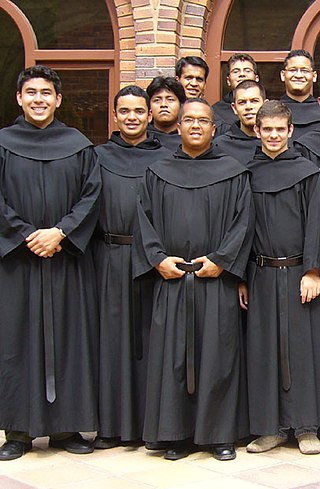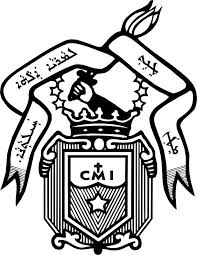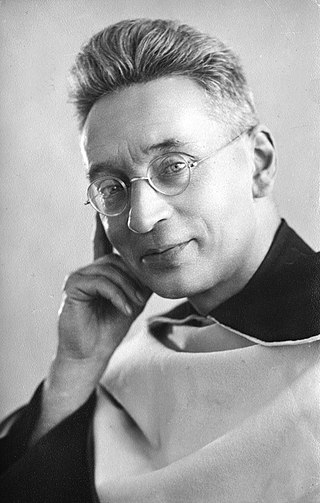
The Order of the Brothers of the Blessed Virgin Mary of Mount Carmel, known as the Carmelites or sometimes by synecdoche known simply as Carmel, is a mendicant order in the Catholic Church for both men and women. Historical records about its origin remain uncertain; it was probably founded in the 12th century on Mount Carmel in what is now Israel.

St. John of the Cross was a Spanish Roman Catholic priest, Christian mystic, and Carmelite friar of Converso ancestry. He is a major figure of the Counter-Reformation in Spain, and he is one of the thirty-seven Doctors of the Church.

A friar is a member of one of the mendicant orders in the Roman Catholic Church. There are also friars outside of the Roman Catholic Church, such as within the Anglican Communion. The term, first used in the 12th or 13th century, distinguishes the mendicants' itinerant apostolic character, exercised broadly under the jurisdiction of a superior general, from the older monastic orders' allegiance to a single monastery formalized by their vow of stability. A friar may be in holy orders or be a non-ordained brother. The most significant orders of friars are the Dominicans, Franciscans, Augustinians, and Carmelites.

The Scapular of Our Lady of Mount Carmel belongs to the habit of both the Carmelite Order and the Discalced Carmelite Order, both of which have Our Lady of Mount Carmel as their patroness. In its small form, it is widely popular among Catholics. Today, it serves as the prototype of all devotional scapulars. The liturgical feast day of Our Lady of Mount Carmel, July 16, is popularly associated with the devotion of the Scapular.

Albert of Jerusalem, OSC, also Albertus Hierosolymitanus, Albertus Vercelensis, Saint Albert, Albert of Vercelli or Alberto Avogadro, was a canon lawyer and saint. He was Bishop of Bobbio and Bishop of Vercelli, and served as mediator and diplomat under Pope Clement III. Innocent III appointed him Patriarch of Jerusalem in 1204 or 1205. In Jerusalem, he contributed the Carmelite Rule of St. Albert to the newly-founded Order of the Brothers of the Blessed Virgin Mary of Mount Carmel. Albert is honoured as a saint in the Roman Catholic Church and commemorated in the liturgical calendar of the Carmelites on 17 September.

The Third Order of Our Lady of Mount Carmel, also known as the Lay Carmelites, is a third order of the Carmelite Order of the Ancient Observance, established in 1476 by a bull of Pope Sixtus IV. It is an association of people who choose to live the Gospel in the spirit of the Carmelite Order and under its guidance. Its members are mainly lay people.

Our Lady of Mount Carmel, or Virgin of Carmel, is a Roman Catholic title of the Blessed Virgin Mary venerated as patroness of the Carmelite Order.

The Carmelites of Mary Immaculate abbreviated CMI, formerly also known as the Servants of Mary Immaculate, is a Catholic clerical religious congregation of pontifical right for men of the Syro-Malabar Catholic Church, and is the largest such congregation in the Syro-Malabar Church.

The Sisters of the Apostolic Carmel are members of a Carmelite religious institute dedicated to female education. It was founded in the latter part of the 19th century by Mother Veronica of the Passion, OCD, under the guidance of her mentor, Bishop Marie Ephrem of the Sacred Heart, OCD, who had envisioned the birth of "a Carmel for the missions" in India, devoted to teaching and education.

The Discalced Carmelites, known officially as the Order of the Discalced Brothers of the Blessed Virgin Mary of Mount Carmel or the Order of Discalced Carmelites, is a Catholic mendicant order with roots in the eremitic tradition of the Desert Fathers. The order was established in the 16th century, pursuant to the reform of the Carmelite Order by two Spanish saints, Teresa of Ávila (foundress) and John of the Cross (co-founder). Discalced is derived from Latin, meaning "without shoes".

Titus Brandsma was a Dutch Carmelite priest and a professor of philosophy. Brandsma was vehemently opposed to Nazi ideology and spoke out against it many times before World War II. He was imprisoned at the Dachau concentration camp, where he was murdered in 1942.

The Rite of the Holy Sepulchre, commonly called the Carmelite Rite, is the liturgical rite that was used by the Canons Regular of the Holy Sepulchre, Hospitallers, Templars, Carmelites and the other orders founded within the Latin Patriarchate of Jerusalem.
Prior is an ecclesiastical title for a superior in some religious orders. The word is derived from the Latin for "earlier" or "first". Its earlier generic usage referred to any monastic superior. In abbeys, a prior would be lower in rank than the abbey's abbot or abbess.

The Carmelite Monks or Monks of the Most Blessed Virgin Mary of Mount Carmel are a public association within the Diocese of Cheyenne, dedicated to a humble life of prayer. The Wyoming Carmelites claim loyalty to the Magisterium of the Catholic Church and to the Carmelite charism. Their life includes strict separation from the world and the living of the cloistered Carmelite spirituality and way of life established by John of the Cross and Teresa of Jesus. In accord with the Carmelite Rule, they engage in manual labor and the study of Carmelite spirituality in the solitude of the mountains, with the firm hope of attaining to Union with God.

The Croatian Carmelite Province of Saint Joseph the Father is a province of the Carmelite Order of the Catholic Church which is active in Croatia, Serbia, Bosnia and Herzegovina, Slovenia, Bulgaria and Albania.
The Book of the First Monks is a medieval Catholic book in the contemplative and eremitic tradition of the Carmelite Order, thought to reflect the spirituality of the Prophet Elijah, honored as the Father of the Order.

Brocard is said to have been one of the first leaders of hermits at Mount Carmel, and was perhaps the leader of the community on the death of Berthold of Calabria around 1195. Various details of his life are legendary.

The Secular Order of Discalced Carmelites, formerly the Secular Order of Discalced Carmelites of the Blessed Virgin Mary of Mount Carmel and of the Holy Mother Saint Teresa of Jesus, is a third order of Catholic lay persons and secular clergy associated with the Discalced Carmelites.

Aylesford Priory, or "The Friars" was founded in 1242 when members of the Carmelite order arrived in England from Mount Carmel in the Holy Land. Richard de Grey, a crusader, sponsored them, and conveyed to the order a parcel of land located on his manor in Aylesford in Kent. The estate came back into the ownership of the Carmelite order in 1949. After refurbishment, which revealed 15th century remnants, the manor house was Grade I listed in 1959. After subsequent work on site, the 15th century gatehouse and the NE section of the wall were also Grade I listed on 25 February 1987. The priory now contains an array of contemporary artworks by notable artists. It is a pilgrimage destination of national significance.

Gregory Homeming OCD is the Bishop of the Roman Catholic Diocese of Lismore. His installation took place on 22 February 2017.















